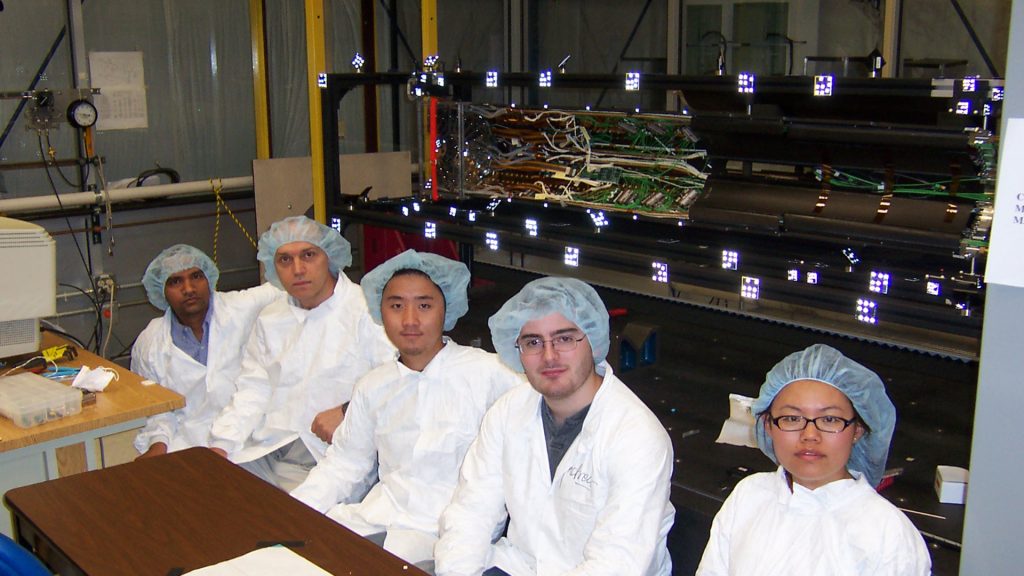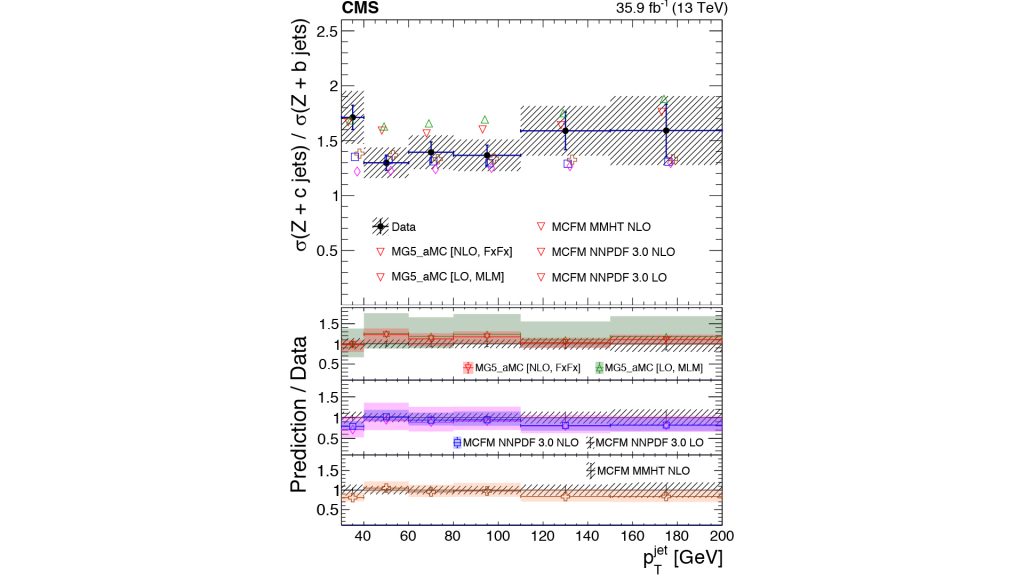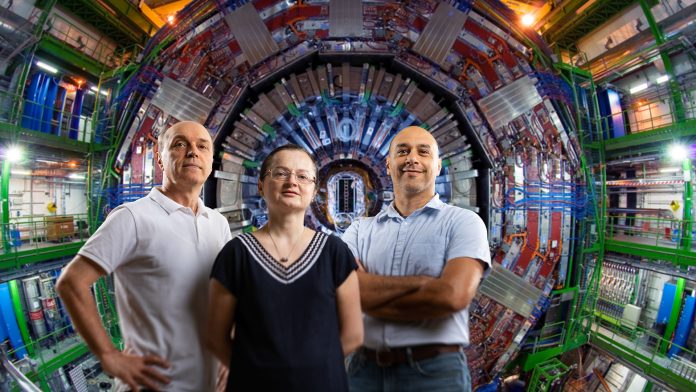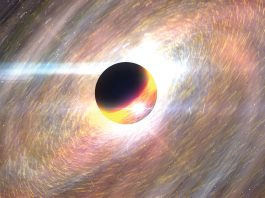Professor Avto Kharchilava reports on University at Buffalo’s involvement in high energy physics research, including joining CERN’s CMS Collaboration, measurements of SM processes and searches for BSM phenomena.
Experimental high energy physics (HEP) at University at Buffalo started in 2005 when two faculty members, Ia Iashvili and Avto Kharchilava, were hired. Both were members of the D0 Collaboration conducting research at Fermilab’s Tevatron collider. The group soon expanded to include two postdocs and a few graduate students, with the group also joining CERN’s CMS Collaboration that same year as an independent institution. More precisely, they ‘re-joined’ the Collaboration, as Iashvili and Kharchilava have contributed to the CMS experiment in the past through its design optimisation studies and physics programme at the LHC (Letter of Intent, 1992, and Technical Proposal, 1994). Our expertise centred around the hardware (tracking detectors), software (jet reconstruction), and physics analysis, such as precise measurements of various Standard Model (SM) processes and searches for Beyond the SM (BSM) phenomena.
From the first days at UB, the group has been involved in running the D0 experiment, contributing to the event reconstruction and calibration infrastructure, the identification of jets originating from c and b quarks, i.e. Heavy Flavour (HF) jets, the simulation of physics processes, and detector response. We have been active in a number of physics analyses such as the SM and BSM Higgs boson searches, measurement of the Z boson or photon production in association with HF jets, and observation of the ZZ production, to name just a few. In parallel, we joined the CMS Forward Pixel Detector (FPix) construction project – a collaboration of several US university groups carried out at Fermilab’s Silicon Detector facility. Upon completion, one of our postdocs went to CERN to help in the installation/integration of the FPix into the CMS experiment and its calibration with cosmic and collider data.
Our two graduate students highly benefitted from the group’s collaboration with the D0 experiment and they both defended their PhD thesis based on the Tevatron data analysis. Since 2012, the UB group grew further by hiring new experimental high energy physics faculty member Sal Rappoccio, and now consists of three faculty, three postdocs, and 10 graduate and undergraduate students. In the following, I highlight our current interests and involvement in the CMS experiment.

Detector operation, computing, event reconstruction
UB group’s responsibilities in these domains include several tasks related to the tracker detector control systems and tests of readout electronics and DAQ in preparations for data taking in collider and cosmic runs. We have also taken extensive roles in collider and simulated data management and the corresponding software developments that, in particular, make use of compressed data tires with reduced information to ease various analysis tasks. Along these lines, we contribute to the CMS facility services to support computing site operations and develop methods to provide flexibility to configure the storage protocols to access data files.
The UB group has been a leader in the reconstruction and calibration of jets, including those from the decays of highly Lorentz-boosted partons. Algorithms have been developed that mitigate effects from multiple interactions in the recorded event, perform jet calibration, and measure jet resolutions in various kinematic regions. These service tasks are essential for the CMS physics programme, and the methods we currently employ are based on
Machine Learning tools.
Another aspect of jet physics is the ability to ‘tag’ them, i.e. to figure out what parent parton(s) a jet originated from. The goal here is to tag HF jets with high probability while maintaining low mis-tagging rates of light quark and gluon jets. We study various jet tagging algorithms, their performance in data and simulations, and provide calibration constants for every data taking period with different experimental conditions.
Precision measurements and the search for New Physics
The expertise in jets, jet calibration, and tagging from the UB group has been applied in precise measurements of various SM processes and innovative searches for new phenomena. We have contributed to several analyses that led to high-profile physics publications. These include a search for BSM Higgs bosons, a search for di-jet resonances, and ttˉ and di-boson resonances in various final states, as well as measurements of the ttˉ production cross section at high Lorentz-boost, and the measurement of the production cross section of di-jet events with respect to jet mass.
The most recent highlight includes a measurement of the associated production of a Z boson with c or b quark jets [Phys. Rev. D102, 032007 (2020)]. These processes provide important tests of perturbative quantum chromodynamics calculations. They also form a major background for a variety of physics processes including Higgs boson (H) production in association with a Z boson when H decays to bbˉ or ccˉ pair. It is important to note that while H→bbˉ decays were observed at LHC in 2018, the H→ccˉ channel will take an order of magnitude larger data sample (and therefore time) to discover. In the latest round of the analysis, we now consider ZH production as a background to the Z+bbˉ process:
Yesterday’s discovery is today’s background – times have really changed! As a side note, the analysis greatly benefited from close collaboration with the UB high energy physics theorists that have strong traditions in collider physics phenomenology and precision calculations.

Prospects
Looking to the future, UB group is engaged with CMS upgrade projects in preparation for the LHC Run 3 that starts in 2022, and for the High-Luminosity LHC, the successor to the LHC, which will begin operation in 2027. We are contributing to the Pixel detector upgrade project and taking part in sensors simulations and tests.
As a final remark, I would mention a brief dialogue that took place at the joint ECFA-EPS session of the 2013 Conference in Stockholm where an accomplished scientist asked: “What does ECFA do to prepare new generations of experimentalists, given that it takes many years to train them?” “Well, we work on the issue,” was the session convenor’s prompt response who pointed to my 10-year-old son who was sitting next to me and curious about some of the big names present in the audience, two of whom were Nobel Laureates, Higgs and Englert. Intriguingly, my son is now a graduate from the UB Gifted Math Program and is applying to colleges with an intended major in physics and maths with a good chance of joining the next generation of (particle?) experimental physicists!
Please note, this article will also appear in the fifth edition of our quarterly publication.









